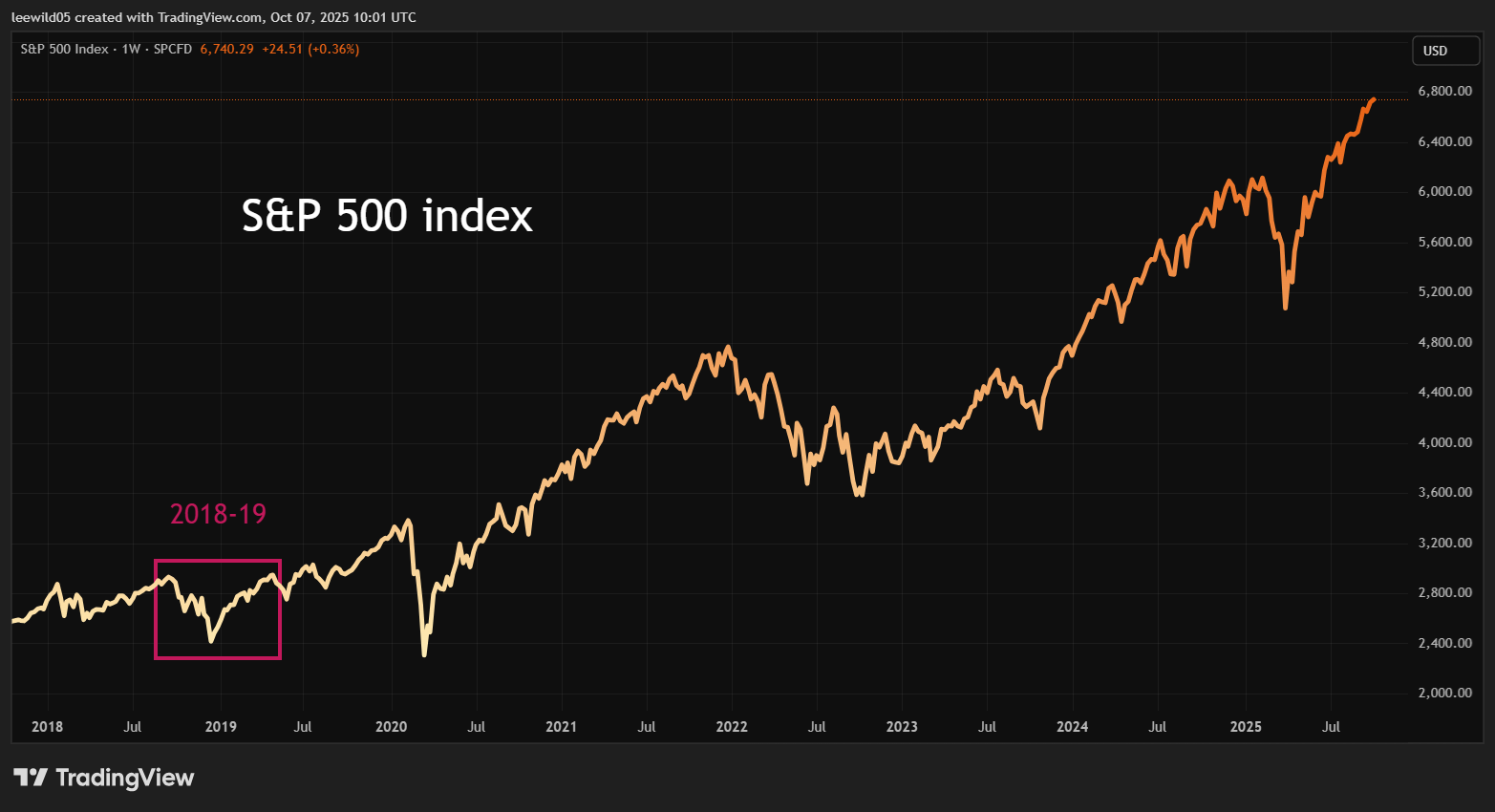Stockwatch: prepare for volatility and range of outcomes
There’s plenty of speculation about the US government shutdown and what it might mean for investors. Analyst Edmond Jackson talks through some of the scenarios.
7th October 2025 12:06
by Edmond Jackson from interactive investor

Does a protracted US government shutdown pose a genuine risk to elevated US equity values and, by implication, other markets?
Compared with previous shutdowns – the last one for 35 days from 22 December 2018 to 25 January 2019 during the first Donald Trump presidency – this one seems more entrenched.
- Invest with ii: SIPP Account | Stocks & Shares ISA | See all Investment Accounts
The nub of the showdown is Democrats seeking an extension of healthcare subsidies due to expire this year-end and sharply raise costs for low-income Americans. Republicans counter that Democrats have shut down the government to provide healthcare to illegal immigrants.
Meanwhile, the Trump administration appears to view the chance to permanently fire – rather than merely furlough – federal workers, as a chance to cut back the state while blaming Democrats for “causing the loss of a lot of jobs”.
Hope is apparent for a temporary agreement by the end of October. It would take a shutdown until December to cause more serious disruption.
Estimates of the hit to gross domestic product (GDP) can seem significant. The White House claims $15 billion (£11.2 billion) GDP could be lost weekly as unemployment rises – possibly to discredit Democrats – yet economists at EY-Parthenon put the cost much lower, at around $7 billion weekly.
Whichever figure you respect – or possibly somewhere in between – they are much higher than the 2018-19 shutdown, which was estimated by the Congressional Budget Office to have cost the US economy at least $11 billion before indirect costs, which are hard to quantify, with around $3 billion never regained. Yet it proved negligible in the context of $21.54 trillion GDP that year.
So, even if the shutdown takes up much of October, the damage might not be enough to materially impact corporate earnings. I am mindful, however, that a relatively moderate impact could coincide with the effect of Trump’s tariffs finally manifesting some stagflation in the fourth quarter.
While the market is absent key economic data during a shutdown, any such upset would be in the context of high US equity values partly driven by euphoria for artificial intelligence (AI).
We’ve been here before with multiple presidents
Shutdowns have effectively been part of the US system – another reason the stock market is so far unperturbed – since 1980 saw a new interpretation of the 1884 Anti-deficiency Act, making it illegal for the government to spend money not approved by Congress. An attorney ruled that departments shut down when their funding lapsed.
Thus, Ronald Reagan’s presidency experienced eight relatively brief shutdowns, while Bill Clinton had one for 21 days and Barack Obama 16 days. There were three shutdowns during Trump’s first presidential term, the longest triggered over funding for the US-Mexico border wall, ending largely because of air travel chaos due to a lack of traffic control staff.
- eyeQ: protection trades amid shutdown scare stories
- Insider: something fishy about this director deal
A compromise could occur if Trump’s approval rating falls. This happened in early 2019 with more than half of Americans blaming Republicans for the impasse. It helped force Trump into an eventual compromise on spending even though he declared a national emergency that February to fund the wall and bypass Congress.
Polling so far has been mixed, but with Republicans taking more criticism than Democrats overall. However, with the US mid-term elections not until November 2026, Republicans could decide there is time enough to fight.
Mind you, this time the two sides are well dug in
Business leaders have urged compromise, but Democrats have resisted, saying they will do so only after Republicans enter talks on health insurance subsidies.
Democrats don’t want to let healthcare cuts go through under their watch, and in turn refuse to back Republican spending plans unless expiring healthcare subsidies are renewed. Democrats also want to see foreign aid cuts restored.
The internecine nature of this conflict is shown by the Trump administration suspending federal infrastructure spending in Democrat-run states such as Chicago and New York.
Perhaps the stock market views Trump as eventually liable to step back from egregious demands similarly as he played the tariffs negotiation from April, where it proved unwise to get spooked by his bluster.
- Shares for the future: time to buy this FTSE 250 stock
- Stockwatch: three shares trading at big discounts
- Sign up to our free newsletter for investment ideas, latest news and award-winning analysis
Yet his administration generally does seem to convey that it believes it has an unchecked mandate. Certainly, if the state is to be radically cut back, then now is the time to be firm. That initiative in the UK came from Dominic Cummings, former chief adviser to Boris Johnson, although it fell away once he departed.
In turn, Democrats have been criticised for not standing strongly enough; their past examples of compromise not yielding positive outcomes.
Political opinions may also be more entrenched among American voters – quite as they are here – hence their representatives feel vindicated, and the stand-off drags on. But the longer it does, the greater disruption to government services and business/consumer confidence.
Stock market remains in ‘all news is good news’ mode
This bullish attitude is helped by the US economy and corporate reporting in 2025, maintaining robust progress that so far defies predictions for Trump’s tariffs.
The precedent is also reassuring. In 2018, the S&P 500 had already dipped from around 2,900 that September to 2,600 in mid-December, then recovered to near 2,700 a few days before the shutdown. Although it dropped briefly to around 2,400 later in December, in April 2019 it passed 2,900.
This time around, the index is up from around 6,660 on 1 October to around 6,740, but [this] did include another wave of AI optimism last Friday.
That’s despite no monthly jobs report appearing because of the shutdown, and with an ongoing lack of data threatening to temper hopes that the Federal Reserve will cut rates further beyond the anticipated reduction this month.

Source: TradingView. Past performance is not a guide to future performance.
Yet in the current “all news is good news” market mood, the longer the shutdown drags on, perhaps a greater chance of rate cuts is seen, to offset economic damage. Unless corporate earnings fall, equities seem primarily interested in the direction of interest rates.
In that regard, should yields on long-term US Treasury bonds rise – a signal to watch out for – amid the stand-off, this (as ever) may affect corporate debt markets and fester to impact equities.
Prepare for volatility and range of outcomes
A medium-term outcome from the deadlock could be near-term financial market instability and a drop for Trump in opinion polls, forcing a compromise. In this case, “buy the drop” in equities.
I still find it hard to envisage where this can happen, especially on the US Medicare programme.
A worse scenario would be state job losses negatively affecting confidence given that the US economy is very much domestic consumer-driven, although this could be offset by tax cuts for wealthier Americans. The cumulative effect of less government departmental spending is a similar risk for aggregate demand.
Worst of all would be if the effects of tariffs start to bite, for example, as lower-priced import stocks of goods for manufacturing or retail dwindle.
So, yes, potential opportunity lies ahead, but if Congress cannot resolve the deadlock, then high US equity values look exposed.
Edmond Jackson is a freelance contributor and not a direct employee of interactive investor.
These articles are provided for information purposes only. Occasionally, an opinion about whether to buy or sell a specific investment may be provided by third parties. The content is not intended to be a personal recommendation to buy or sell any financial instrument or product, or to adopt any investment strategy as it is not provided based on an assessment of your investing knowledge and experience, your financial situation or your investment objectives. The value of your investments, and the income derived from them, may go down as well as up. You may not get back all the money that you invest. The investments referred to in this article may not be suitable for all investors, and if in doubt, an investor should seek advice from a qualified investment adviser.
Full performance can be found on the company or index summary page on the interactive investor website. Simply click on the company's or index name highlighted in the article.
Disclosure
We use a combination of fundamental and technical analysis in forming our view as to the valuation and prospects of an investment. Where relevant we have set out those particular matters we think are important in the above article, but further detail can be found here.
Please note that our article on this investment should not be considered to be a regular publication.
Details of all recommendations issued by ii during the previous 12-month period can be found here.
ii adheres to a strict code of conduct. Contributors may hold shares or have other interests in companies included in these portfolios, which could create a conflict of interests. Contributors intending to write about any financial instruments in which they have an interest are required to disclose such interest to ii and in the article itself. ii will at all times consider whether such interest impairs the objectivity of the recommendation.
In addition, individuals involved in the production of investment articles are subject to a personal account dealing restriction, which prevents them from placing a transaction in the specified instrument(s) for a period before and for five working days after such publication. This is to avoid personal interests conflicting with the interests of the recipients of those investment articles.